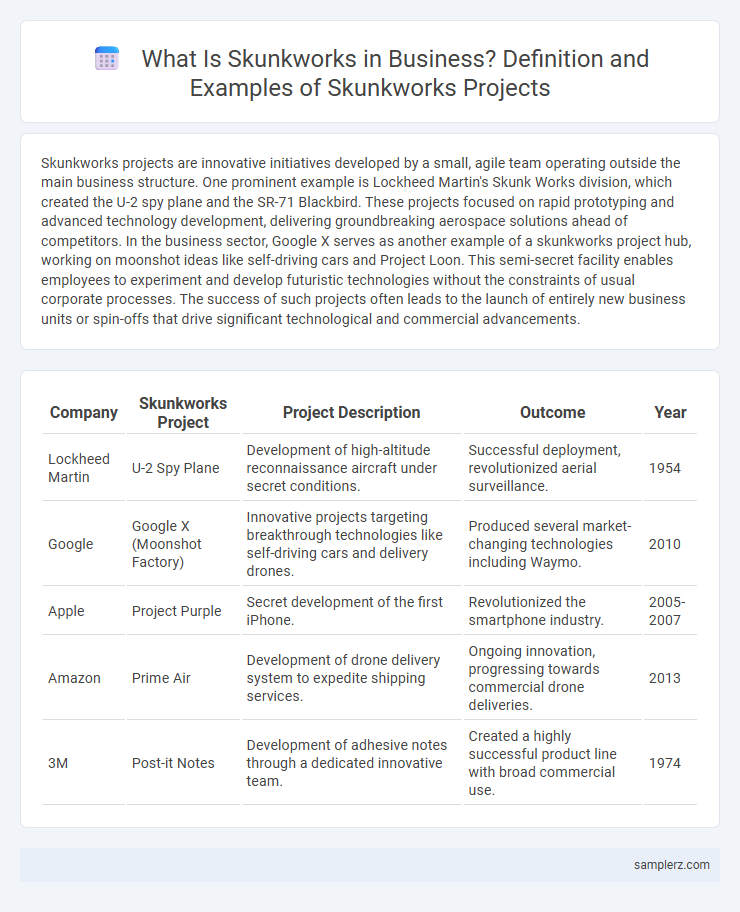Skunkworks projects are innovative initiatives developed by a small, agile team operating outside the main business structure. One prominent example is Lockheed Martin's Skunk Works division, which created the U-2 spy plane and the SR-71 Blackbird. These projects focused on rapid prototyping and advanced technology development, delivering groundbreaking aerospace solutions ahead of competitors. In the business sector, Google X serves as another example of a skunkworks project hub, working on moonshot ideas like self-driving cars and Project Loon. This semi-secret facility enables employees to experiment and develop futuristic technologies without the constraints of usual corporate processes. The success of such projects often leads to the launch of entirely new business units or spin-offs that drive significant technological and commercial advancements.
Table of Comparison
| Company | Skunkworks Project | Project Description | Outcome | Year |
|---|---|---|---|---|
| Lockheed Martin | U-2 Spy Plane | Development of high-altitude reconnaissance aircraft under secret conditions. | Successful deployment, revolutionized aerial surveillance. | 1954 |
| Google X (Moonshot Factory) | Innovative projects targeting breakthrough technologies like self-driving cars and delivery drones. | Produced several market-changing technologies including Waymo. | 2010 | |
| Apple | Project Purple | Secret development of the first iPhone. | Revolutionized the smartphone industry. | 2005-2007 |
| Amazon | Prime Air | Development of drone delivery system to expedite shipping services. | Ongoing innovation, progressing towards commercial drone deliveries. | 2013 |
| 3M | Post-it Notes | Development of adhesive notes through a dedicated innovative team. | Created a highly successful product line with broad commercial use. | 1974 |
Introduction to Skunkworks in Business Projects
Skunkworks in business projects represents an innovative approach where autonomous teams develop breakthrough products or solutions outside standard corporate processes. This method originated with Lockheed Martin's Advanced Development Programs, renowned for creating cutting-edge aerospace technologies rapidly and with high secrecy. Implementing skunkworks teams encourages agility, creativity, and risk-taking, enabling companies like Google and Apple to pioneer transformative technologies efficiently.
Defining Skunkworks: Key Characteristics
Skunkworks projects are characterized by small, autonomous teams working rapidly and secretly to innovate beyond traditional corporate constraints. These teams operate with minimal bureaucracy, allowing for high levels of creativity and risk-taking essential for breakthrough business solutions. Emphasizing flexibility and independence, skunkworks environments foster breakthroughs in product development, such as Lockheed Martin's innovative aircraft projects.
Notable Corporate Skunkworks Initiatives
Lockheed Martin's Skunk Works division is a prime example of a corporate skunkworks initiative, credited with developing advanced aircraft such as the U-2 spy plane and the stealth F-117 Nighthawk. Google X, now known as X Development, operates as Alphabet's innovation lab, pioneering projects like self-driving cars and Project Loon. These initiatives exemplify how corporate skunkworks drive breakthrough innovations by fostering agile, secretive environments shielded from traditional organizational processes.
Skunkworks Example: Lockheed Martin’s Pioneering Projects
Lockheed Martin's Skunk Works division exemplifies groundbreaking innovation with projects like the U-2 reconnaissance aircraft, the SR-71 Blackbird, and the F-117 Nighthawk stealth fighter. These pioneering projects showcased rapid prototyping, secrecy, and advanced aeronautical engineering, setting industry benchmarks in defense technology development. Skunk Works' approach accelerated timelines and minimized bureaucratic hurdles, driving high-impact results in military aerospace.
Google X: A Modern Skunkworks Success Story
Google X exemplifies a modern skunkworks project by fostering radical innovation through small, autonomous teams working on breakthrough technologies like self-driving cars and smart contact lenses. Its approach emphasizes rapid prototyping, secrecy, and freedom from traditional corporate constraints, enabling disruptive product development in areas such as artificial intelligence and renewable energy. The success of Google X highlights how dedicated innovation hubs can drive substantial advancements and competitive advantage in the tech industry.
Apple’s Secretive iPhone Development Team
Apple's secretive iPhone development team, often referred to as a skunkworks project, operates with high autonomy to innovate cutting-edge technology away from the main corporate structure. This team's breakthrough designs, such as the original iPhone, emerged through rapid prototyping and confidential collaboration, bypassing conventional approval processes. Their success demonstrates how skunkworks fostered creativity and accelerated product development in highly competitive markets.
Microsoft’s Garage: Fostering Innovation through Skunkworks
Microsoft's Garage exemplifies skunkworks by empowering employees to rapidly develop experimental projects outside formal organizational constraints. This innovation hub supports a culture of creativity and risk-taking, enabling teams to prototype and iterate technologies like Microsoft's AI-powered tools and productivity apps. Through fostering autonomous, cross-disciplinary collaboration, Microsoft's Garage accelerates breakthrough solutions that drive competitive advantage in the tech industry.
Benefits of Applying the Skunkworks Model in Projects
The Skunkworks model in projects accelerates innovation by fostering autonomous teams with minimal bureaucracy, allowing rapid development and iterative prototyping. This approach enhances creativity, reduces time-to-market, and increases flexibility in responding to dynamic business challenges. Examples from companies like Lockheed Martin demonstrate significant breakthroughs achieved through dedicated, isolated project units focused on disruptive solutions.
Challenges Faced by Skunkworks Teams in Business
Skunkworks teams often face challenges such as limited resources, tight deadlines, and resistance from established corporate structures. The need for rapid innovation can create pressure that impacts team morale and productivity. Navigating organizational politics while maintaining secrecy and autonomy remains a critical obstacle for these specialized project groups.
Best Practices for Implementing Skunkworks in Your Organization
Implementing skunkworks projects in your organization requires establishing a dedicated, autonomous team with clear innovation goals and access to necessary resources, fostering a culture of trust and rapid iteration. Protecting the project from bureaucratic constraints and enabling direct communication with executive leadership accelerates decision-making and creative problem-solving. Regularly reviewing progress through milestone-based evaluations ensures alignment with strategic business objectives without stifling the team's entrepreneurial spirit.

example of skunkworks in project Infographic
 samplerz.com
samplerz.com